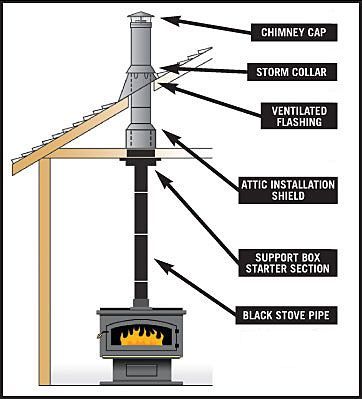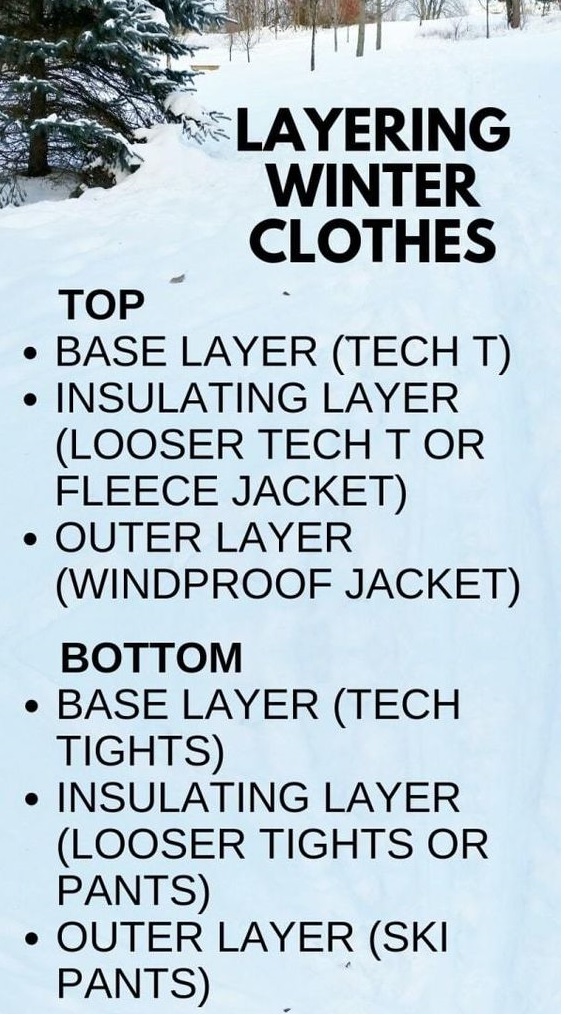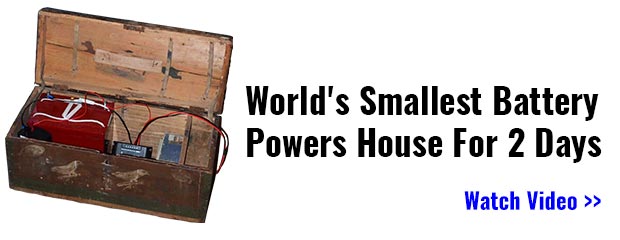Just in case you haven’t noticed, winter is here.
Oh, it might not officially be here, but winter weather definitely is. It’s even hit South Texas, where there was almost… but not quite, a freeze. For anyone who has ever lived in the southern part of Texas, you know that’s a big deal. They can go whole winters without one single day that gets close to freezing. But not this time.
As always, people across the country and around the world are seeking ways of keeping warm. I don’t get cold all that easily, so that’s not much of a worry for me. But I know a lot of people who get cold extremely easily. Just let it drop below 60°F and they act like the abominable snowman moved in next door.
World’s Smallest Battery Will Power Your House For More Than 2 Days!
Heating your home can be expensive; perhaps not as expensive as cooling it, but expensive nevertheless. The largest portion of our personal energy use is dedicated to that one purpose; and if you have electric heat, it’s even worse.
Paying for that heating can be a major stress on any family’s budget. Worse than that, what’s going to happen to us when the lights go out and we don’t have electricity to count on? Our modern home heating systems all depend on electricity to operate, even if you heat with gas. When the electricity shuts off, so does the heat. That could be disastrous to the people of California, considering how they’re living through rolling blackouts right now.
Yet our ancestors managed to keep themselves warm, without spending a fortune on heating. The great thing about this is that most of their methods will work for us today. We can use them for emergency heating or just to lower our home heating bills. If you work it out right, you might be able to keep your family warm all winter, for next to nothing.
So how do we do that?
Wood Heating
Throughout history, mankind has heated our homes with wood. From the earliest times, when a fire pit in the middle of the floor and a smoke hole in the roof were the heating methods, until today, where some people still heat with wood in efficient wood-burning stoves, our forests have kept countless millions of people warm. Wood is a renewable resource, which provides an economic way to heat.
Of course, if you’re going to heat with wood, you’re going to need a wood-burning stove in your home. I’d forget about the idea of a fireplace, even though they are pretty. They’re just not as efficient. Ben Franklin invented his Franklin stove because his fireplace was inefficient, sending most of the heat up the chimney. Today’s wood-burning stoves are even more efficient than Franklin’s model.
They are also more efficient in the way that they burn the wood, guaranteeing that you get as much of the energy stored in that wood as possible. EPA regulations for modern wood-burning stoves are extremely strict. But that’s actually good for you and I, as it helps lower operating costs.
Retrofitting a wood-burning stove into a home is also much easier than installing a fireplace. It’s just easier to prepare a fire-resistant place to put the stove, than it is to build a home for the fireplace. But in either case, the really hard part is the chimney, especially if you have a two-story home.
Running a chimney up through the attic and roof really isn’t all that bad. The problem comes in when you have to run the chimney up through the second floor. Finding a place where you can do that, without messing up at least one of your bedrooms, is difficult at best. In some cases, it might actually be better to run the chimney up outside of the home.
Saving on Wood
 One of the great things about heating with wood is that you can harvest the fuel yourself. That’s not possible with fossil fuels or nuclear energy. It is possible to harvest your own solar or wind power, although the initial investment in equipment can be high. It is also possible for some people to use hydropower, although most of us don’t have that option available to us, simply because we don’t have a river available to us.
One of the great things about heating with wood is that you can harvest the fuel yourself. That’s not possible with fossil fuels or nuclear energy. It is possible to harvest your own solar or wind power, although the initial investment in equipment can be high. It is also possible for some people to use hydropower, although most of us don’t have that option available to us, simply because we don’t have a river available to us.
But wood is cheap; at least, it’s cheap if you harvest it yourself; and that’s something you can do, if you’ve got a chainsaw and a pickup truck or trailer. You don’t even have to go very far to do so; all you’ve got to do is be willing to spend a little time doing some physical work.
I’m not talking about going out to the woods to harvest your wood. Chances are, no matter where you live, there are plenty of places nearby where you can harvest firewood in your spare time.
- Look around after a storm to see where there are branches down. Offer to cut those branches up and haul them off for free. About the only homeowners who wouldn’t jump at that are people who want to use the wood themselves.
- You can do the same with tree branches that have fallen on the streets, showing yourself as a good citizen and helping out the neighborhood. They don’t need to know that you’re doing it for other reasons.
- Offer to remove dead trees from people’s property. That usually costs homeowners a few hundred bucks. They’d be glad to have you come in and remove those trees for free.
- Keep your eyes open for new construction projects. Often, the contractors need to clear trees from the site, before they can begin work. That gives you an opportunity to help with the clearing process, either in cutting trees for your use or in picking up some of the trees that have been uprooted by bulldozers. Check with the contractor and see what you can do.
- People will often have branches stacked by the side of the road, waiting for the trash man to pick them up. I’ve garnered a lot of wood that way, as nobody minds me picking it up.
- Find out where your local pallet recycling businesses are. They often have a stack of pallets that are not recyclable. Some bust those up and sell them as firewood, but most don’t bother. Offer to haul a bunch of them off and they’ll probably give them to you for free.
- Check with small businesses, especially ones that are renting the combination office/warehouse buildings that have sprung up all over. Often they get palletized inventory shipped in and need to dispose of those pallets. These companies aren’t big enough that the pallet recyclers bother with them, so they are often happy to have someone come pick up their unused pallets.
Of course, you always want to make sure that you check with the appropriate homeowners, contractors or city officials, before beginning to cut any downed limbs or cut down any trees. In most cases, it’s not hard to get permission; but you want to be sure that you have that permission, so that nobody calls the police on you.
You also want to make sure that you leave things nice and neat when you’re done. You may not be able to pick up everything, but raking up the area and making sure that you don’t leave a mess will go a long way towards maintaining goodwill.
Keep in mind that freshly cut wood needs time to season, drying out, before you try burning it in your wood-burning stove. It’s usually a good idea to be thinking a year ahead-of-time, stockpiling wood now for next winter and using last year’s wood harvesting to heat your home this winter. If you’re just starting out and don’t have a wood pile from last year, you might want to buy a wood moisture meter, so you can see what the moisture level of your finds is and know what you can burn.
Wood Can’t Heat Your Whole Home
One thing that many people don’t realize is that wood can’t heat your whole home. At least, to put that more clearly, one wood-burning stove in the living area of your home won’t make your whole house toasty warm. It will keep the living areas warm and keep the bedrooms from freezing, but that’s about it.
Other than the most wealthy of our ancestors, who could afford a stove or fireplace in every room, this was a common understanding in the past. That’s why the children often slept in the loft of a home; as the rising heat would keep the loft warm.
One thing you can do, to help move the heat around your home, is to make good use of fans, especially ceiling fans. All ceiling fans will run in either direction, allowing you to have it push air down in the summer and up in the winter. As the cold air moves up, it pushes the warm air up at the ceiling towards the edges of the room and down. From there, it will naturally go into other parts of the house, as long as the doors are open.
Use Clothing Wisely
 I’ve spent a lot of time in Mexico, where most people don’t bother to heat their homes. In fact, they don’t have the ability to do so. Instead, they dress warmly, in layers, in their homes. As winter progresses, they become more accustomed to the cold weather; even though their idea of cold weather is nothing like our own.
I’ve spent a lot of time in Mexico, where most people don’t bother to heat their homes. In fact, they don’t have the ability to do so. Instead, they dress warmly, in layers, in their homes. As winter progresses, they become more accustomed to the cold weather; even though their idea of cold weather is nothing like our own.
We tend to heat our homes, rather than using clothing to keep us warm. That’s because we try to dress in clothing that’s really not warm enough for the weather. Oh, we might wear long sleeves, rather than short ones, but the fabric isn’t going to be any warmer. On the other hand, if we were to add another layer of clothing as a matter of course, we could keep our homes several degrees cooler and stay comfortable.
Hats and Socks
The most important clothing items to keep you warm are hats and socks. A full one-fourth of our body’s blood circulates to the head, providing the brain with oxygen. That also brings a lot of our core body heat up to the head, where it can dissipate into the air. Wearing a hat goes a long way towards keeping that heat in our bodies and keeping us from getting cold. Hence the old adage about “if your feet are cold, put on a hat.”
Speaking of feet; they are the part of your body which is likely to feel the cold first, being the farthest from your heart. One of the things that our bodies do to preserve our core heat is to restrict blood flow to the extremities when we get cold. That’s what causes our feet to get cold.
Putting on a hat will go a long way towards keeping your toes warm; but don’t stop there. It only makes sense to always wear warm socks or slippers around the house. I tend to wear sandals most of the year, but when it gets cold, I switch over to warm socks or sandals. I even go so far as to sleep with socks on, if it’s really cold.
A Warm Bed
The biggest problem with only heating part of your home is going to bed at night. Unless you move your beds into the living room, chances are that you’re not going to have a wood-burning stove pumping out heat in your bedroom.
That’s why a bed-warmer is so important. This old-fashioned device looked like a pan with a long handle and a metal lid. Most people thought it would be filled with coals, but in fact, they were filled with stones, and the bed-warmer, with its rocks inside, was heated in the fire. Coals would get ash all over the sheets, making them dirty. When the heated bed-warmer was slipped between the sheets, it could heat the bed up, making it possible to get a good night’s sleep.
Don’t forget to pile the blankets on either. The mattress provides insulation for the side of your body that is laying on it, but you need insulation for the top side too. A few extra blankets, thrown on your bed, will keep you warm, no matter how cold it gets in your house.
Portable Heat
Nowadays, we use small electric or kerosene heaters for localized heat. Those work well, but the electric heaters aren’t very efficient, cost-wise. Kerosene is, assuming you live someplace where people regularly use it. On the other hand, if you live someplace like I do, the only place you can buy kerosene is at a paint store and it’s much too expensive to use for heating.
What our ancestors did was to use soapstones for portable heat. Soapstone is an interesting material, in a number of different ways. Made primarily of talc, it is rather soft and easy to work. But for our purposes, the most important characteristic of it is that it has a very high heat coefficient. So it will absorb a lot of heat and radiate that heat into its surroundings.
They would heat soapstones in the coals of their fire, then take them out and wrap them in a fabric carrier or towel. Then they could take that warm stone with them, providing heat wherever they needed it. One such way would be to put the soapstone under the seats of their wagon, with a blanket across their laps. That way, the soapstone could help keep them warm in an open wagon.
Another way the soapstone was used was in church. Some better-off churches from the 1800s would have enclosed family pews. That was so that they could put their heated soapstone under the pew, with a blanket across their laps to keep the family warm.
We could use something like this to bring heat to other rooms of the house. While it wouldn’t heat a whole room, soapstones under desks and tables could provide portable heat, without burning all that electricity.
A Final Word
I’ve presented these ideas with the idea that they can be used to reduce your current heating bill. They will do that, if you use them. You could also combine these ideas with your current HVAC system, using wood to heat the living areas of your home and the HVAC to heat your bedrooms at night. A simple zoning valve would make this very functional.
At the same time, if you were to put these ideas into practice, you would be preparing your home and your family for living in a grid down situation. You wouldn’t be able to augment your wood heat with your HVAC system in that time, but at least you’d still have heat.











































































We have a natural gas furnace but the thermostat is electric. We supplement with kerosene. The price varies from year to year (up this year from last) but it does help to keep the electric bill dow (we utilize electric space heaters as well). As backup, we also have a couple different size Mr. Buddy propane heaters. We camp often, that’s why we have so many different options. Keep in mind that using alternative heating methods requires vigilance. Make sure that you have good ventilation, and not only smoke detectors but co2 detectors.
Layering clothes is an important and often overlooked consideration. Underclothes are something we don’t often discuss. I personally wear a tank top all winter long under my other layers. (When I was a kid, we all wore ‘undershirts) Keeping your back and kidneys warm helps a lot. There is a whole thing out there about ‘kidney wrapping’. I fully agree with Bill that keeping your extremities warm are of utmost importance. I am not a big fan of hats. But when it is cold, you do what you need. I sleep with a pillow over my head in the winter.
Doing a rocket stove could be an economical way to supplement a wood stove or other heating avenues.
Some pallets are soaked in chemicals and should not be reused or burned. I think there is a code stamped on them telling what type they are.
Yes be careful of the pallets. So are international pallets sprayed for bugs not good to burn at all the stamp looks like. A wheat shaft